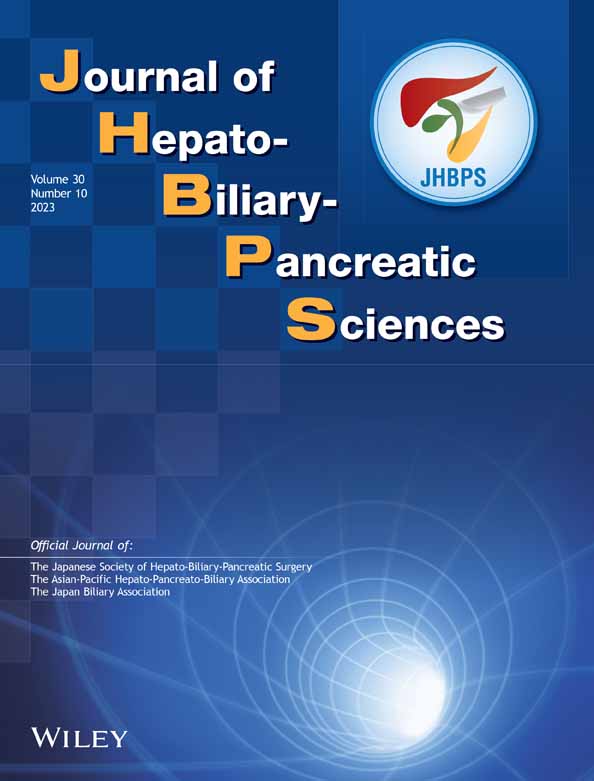HOW I DO IT
Stent-in-stent technique in a case of difficult removal of a EUS-guided hepaticogastrostomy partially covered metal stent due to mucosal hyperplasia (with video)
Takeshi Ogura,
Corresponding Author
Takeshi Ogura
Endoscopy Center, Osaka Medical and Pharmaceutical University Hospital, Osaka, Japan
2nd Department of Internal Medicine, Osaka Medical and Pharmaceutical University, Osaka, Japan
Correspondence
Takeshi Ogura, Endoscopy Center, Osaka Medical College, 2-7 Daigakuchou, Takatsukishi, Osaka 569-8686, Japan.
Email: [email protected]
Search for more papers by this author Yuki Uba,
Yuki Uba
2nd Department of Internal Medicine, Osaka Medical and Pharmaceutical University, Osaka, Japan
Search for more papers by this author Hiroki Nishikawa,
Hiroki Nishikawa
2nd Department of Internal Medicine, Osaka Medical and Pharmaceutical University, Osaka, Japan
Search for more papers by this author
Takeshi Ogura,
Corresponding Author
Takeshi Ogura
Endoscopy Center, Osaka Medical and Pharmaceutical University Hospital, Osaka, Japan
2nd Department of Internal Medicine, Osaka Medical and Pharmaceutical University, Osaka, Japan
Correspondence
Takeshi Ogura, Endoscopy Center, Osaka Medical College, 2-7 Daigakuchou, Takatsukishi, Osaka 569-8686, Japan.
Email: [email protected]
Search for more papers by this author Yuki Uba,
Yuki Uba
2nd Department of Internal Medicine, Osaka Medical and Pharmaceutical University, Osaka, Japan
Search for more papers by this author Hiroki Nishikawa,
Hiroki Nishikawa
2nd Department of Internal Medicine, Osaka Medical and Pharmaceutical University, Osaka, Japan
Search for more papers by this author
First published: 21 February 2023
No abstract is available for this article.
CONFLICT OF INTEREST STATEMENT
The authors have no conflicts of interest to declare.
| Filename |
Description |
| jhbp1318-sup-0001-VideoS1.mp4MPEG-4 video, 15.8 MB |
Video S1. An ERCP catheter was inserted into the EUS-HGS stent. A guidewire was deployed into the intrahepatic bile duct. Cholangiography showed mucosal hyperplasia at the distal end of the EUS-HGS stent. Since stent removal could not be performed, a fully covered self-expandable metal stent was deployed to compress the mucosal hyperplasia. After 7 days, stent removal was attempted and successfully completed without any adverse events.
|
Please note: The publisher is not responsible for the content or functionality of any supporting information supplied by the authors. Any queries (other than missing content) should be directed to the corresponding author for the article.
REFERENCES
- 1Ogura T, Higuchi K. Technical review of developments in endoscopic ultrasound-guided hepaticogastrostomy. Clin Endosc. 2021; 54: 651–9.
- 2Sundaram S, Dhir V. EUS-guided biliary drainage for malignant hilar biliary obstruction: a concise review. Endosc Ultrasound. 2021; 10: 154–60.
- 3Yamamura M, Ogura T, Ueno S, Okuda A, Nishioka N, Yamada M, et al. Partially covered self-expandable metal stent with antimigratory single flange plays important role during EUS-guided hepaticogastrostomy. Endosc Int Open. 2022; 10: E209–14.
- 4Nakai Y, Sato T, Hakuta R, Ishigaki K, Saito K, Saito T, et al. Long-term outcomes of a long, partially covered metal stent for EUS-guided hepaticogastrostomy in patients with malignant biliary obstruction (with video). Gastrointest Endosc. 2020; 92: 623–31.e1.
- 5Tan DM, Lillemoe KD, Fogel EL. A new technique for endoscopic removal of uncovered biliary self-expandable metal stents: stent-in-stent technique with a fully covered biliary stent. Gastrointest Endosc. 2012; 75: 923–5.




